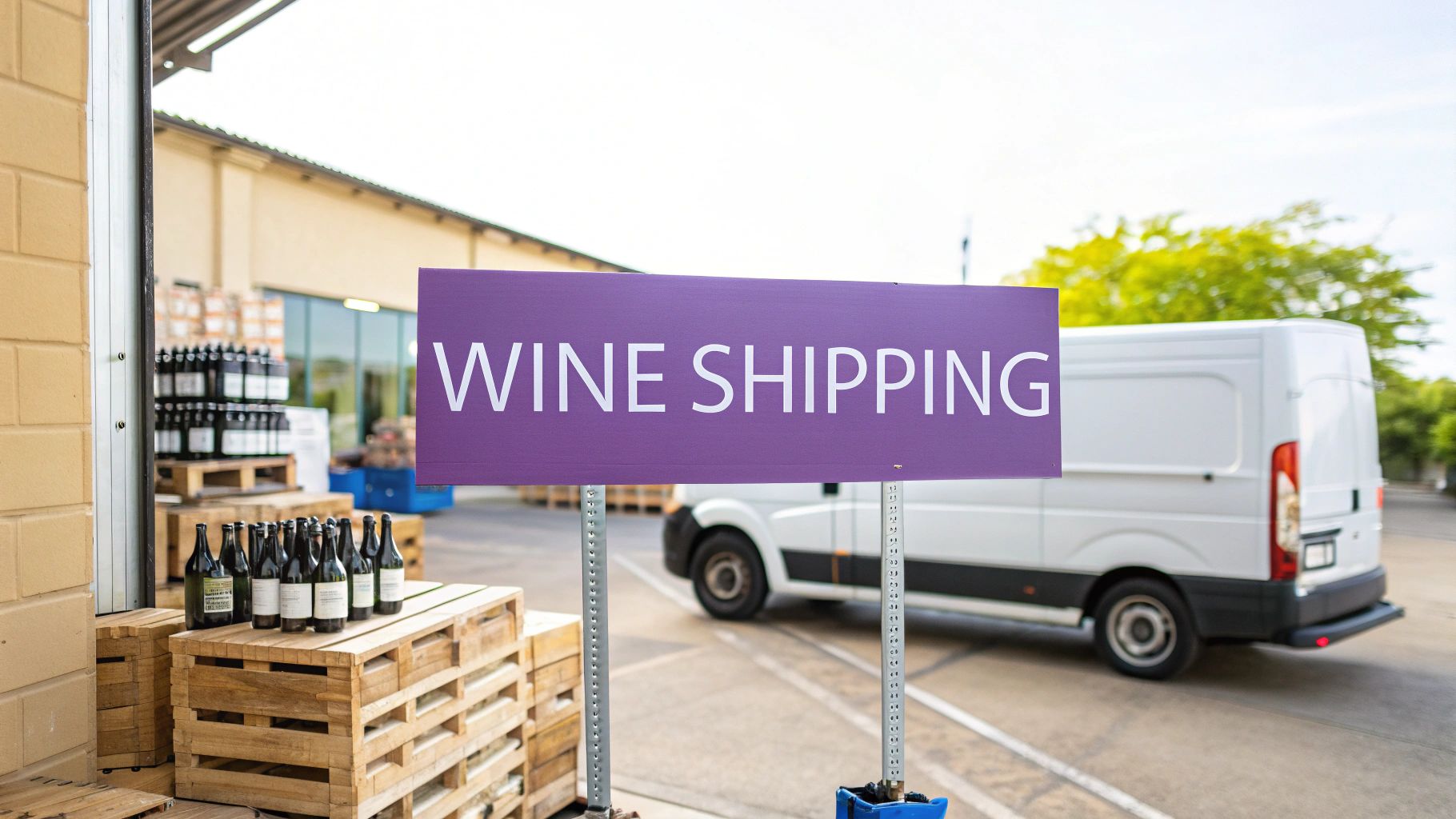
A Guide to Shipping Wine by FedEx
Learn how to start shipping wine by FedEx with this guide. Get practical advice on licensing, packaging, and navigating complex state and international laws.
Cody Y.
Updated on Aug 20, 2025
So, you want to ship wine with FedEx? The first thing to know is that this isn't like sending a regular package. It’s a specialized service reserved exclusively for licensed businesses. You can't just walk into a FedEx store with a bottle of wine and send it on its way; you have to be an approved, licensed entity with a signed FedEx Alcohol Shipping Agreement. This is the only way to legally ship wine and ensure everything is above board from start to finish.
Getting Started with FedEx Wine Shipments
Before you even think about boxes or labels, shipping wine with FedEx demands a solid legal and logistical foundation. Unlike shipping a book or a t-shirt, alcohol is a heavily regulated product. FedEx has a strict set of protocols to make sure every shipment is compliant, and that whole process starts long before a bottle is ever packed. Getting this initial setup right is the most critical part of the process—it's the bedrock for your entire shipping operation.
The first step is a hard requirement: you must hold the right federal and state licenses that allow you to sell and ship alcohol. We're not talking about a general business license, but specific alcohol permits that can vary dramatically from one state to another. Without these, you can't even get in the door.
Becoming an Approved Alcohol Shipper
Once your licenses are in order, you need to formally partner with FedEx by signing their Alcohol Shipping Agreement. This isn't your standard business account; it's a special contract where you officially agree to follow all applicable laws and FedEx’s own strict policies.
This agreement is what separates a licensed winery or retailer from someone just trying to mail a gift. It creates a clear line of accountability and confirms you understand—and accept—the responsibilities involved.
The FedEx website gives a good overview of their alcohol shipping program, which is a great starting point.
Think of this page as the main hub for licensed shippers. It lays out the requirements for permits, packaging, and the specific services you can use. It makes one thing perfectly clear: only FedEx-approved, licensed businesses get to play.
Key Compliance Requirements
After setting up your account and signing the agreement, your duties as a shipper really come into focus. FedEx has a clear set of rules you have to follow for every single package that has wine in it.
Here are the core requirements you'll live by:
- Proper Licensing: You must keep your licenses valid at your shipping location and confirm that the destination state legally allows direct-to-consumer (DTC) wine shipments.
- FedEx Agreement: The Alcohol Shipping Agreement has to be active and linked to your account. No agreement, no shipping.
- Approved Packaging: You can only use FedEx-approved packaging. This usually means molded pulp or foam inserts specifically designed to protect bottles and prevent breakage.
- Correct Labeling: Every box needs a special label that clearly identifies it as containing alcohol and, critically, requires an adult's signature upon delivery.
It’s worth repeating: only FedEx-approved, licensed shippers can send wine. For domestic shipments, FedEx offers several service levels, though some locations might have restrictions. If you're shipping internationally, your options are more limited—expedited services like International Priority are allowed, but FedEx International Ground is off-limits. It's a good idea to explore the service-level specifics on the FedEx site to make sure you're always choosing a compliant option.
Navigating State and International Regulations
Let's be honest: understanding the legal side of shipping wine is often the biggest headache. Once you get your FedEx approval, you're responsible for navigating a complex maze of state and international rules. This isn't a "one-size-fits-all" deal; the laws change dramatically from one border to the next, and compliance is absolutely non-negotiable.
Direct-to-consumer (DTC) shipping laws in the U.S. are a perfect example of this mess. One state might welcome your shipments with open arms, while its neighbor could demand painstaking monthly reports, cap your volume, or just ban DTC wine shipping entirely. Dropping the ball on these rules can lead to seized packages, painful fines, and even losing your shipping privileges for good.
The High Stakes of State Compliance
States are cracking down, and they're getting better at it. Regulatory bodies are actively tracking shipments to make sure every bottle is accounted for and every last tax dollar is paid. This means meticulous records and sticking to local laws are more critical than ever.
Shipping wine into certain states with FedEx, for instance, can feel like you're under a microscope. In Texas alone, the Alcoholic Beverage Commission flagged 304,481 unreported or illegal wine shipments in just one quarter of 2022. Tennessee also saw a major enforcement push where FedEx was ordered to stop 240 illegal shipments in a single year. These aren't just warnings; they're proof of the serious fallout from non-compliance.
Automating Your Compliance Checks
Trying to manually check the shipping eligibility for every single address is a recipe for disaster. It's not just slow—it's incredibly prone to human error. One simple mistake, like shipping to a dry ZIP code in a state that otherwise allows it, can put your entire business on the line. This is where automation becomes your best friend.
"The difference between a successful delivery and a returned shipment often comes down to one thing: accurate, real-time address validation. You can’t afford to guess when it comes to state and local alcohol laws."
This image gives a quick comparison of a few popular protective packaging materials for wine.
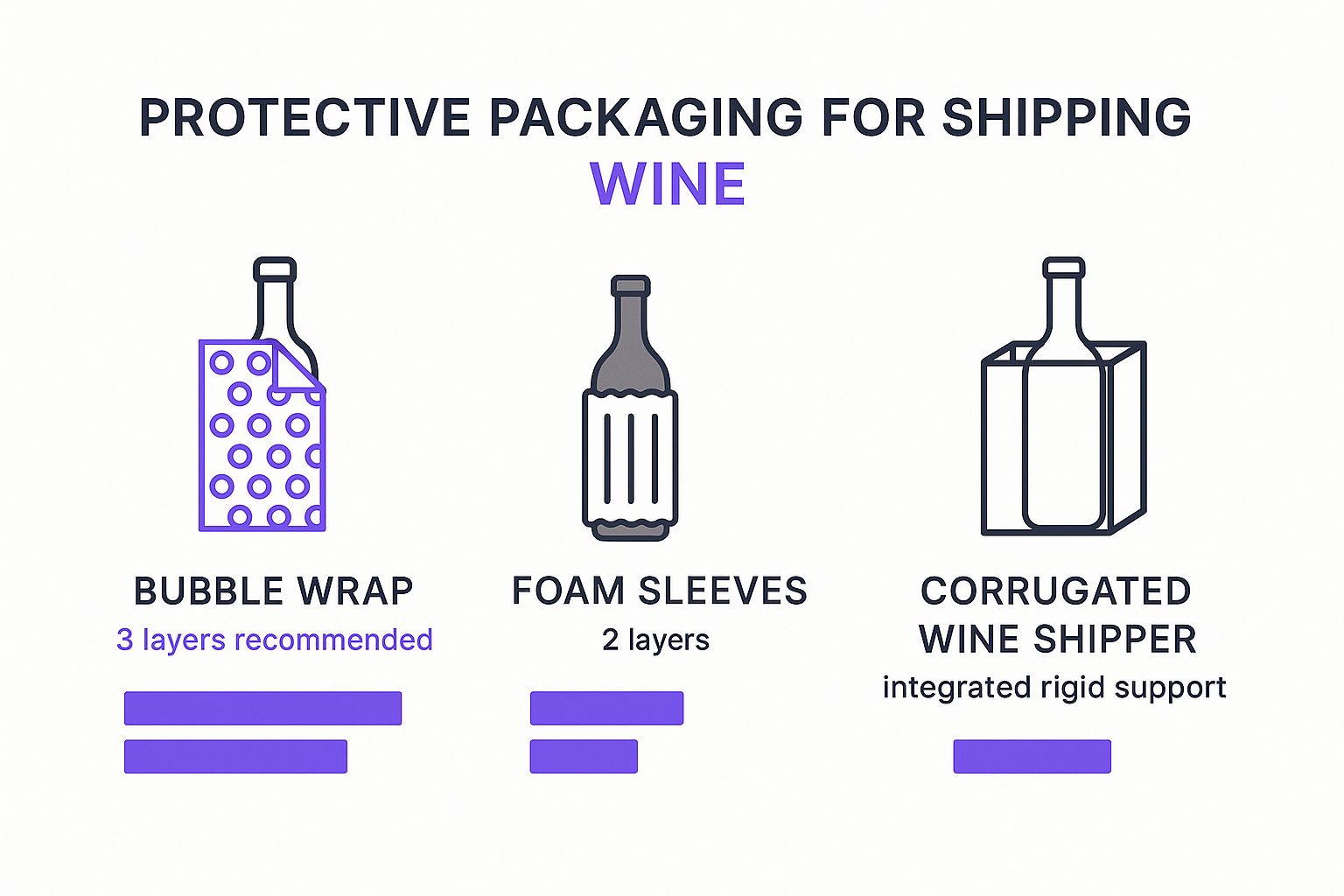
As you can see, while bubble wrap might require more layers, corrugated shippers offer built-in support that really simplifies the packing process.
Tools built specifically to manage shipping restrictions for alcohol can instantly verify if a customer’s address is in a location where you're licensed to ship. This tech cross-references state, county, and even hyper-local rules in real-time, blocking prohibited orders before they're ever placed. Think of it as an essential insurance policy for your business.
International Shipping Complexities
If you're thinking about shipping wine internationally with FedEx, get ready for a whole new level of regulatory hurdles. Every country has its own unique playbook for things like:
- Customs Declarations: You'll be filling out detailed commercial invoices for every shipment.
- Tariffs and Taxes: These fees can vary wildly and must be settled before the wine is released to your customer.
- Import Licenses: Some countries require the recipient to hold a special license just to receive alcohol.
There are generally two ways to ship internationally: licensee-to-licensee (like to an importer) and licensee-to-consumer (DTC). The DTC route is far more complicated and is only allowed in a handful of countries. Before you even think about an international shipment, do your homework. Always verify the destination country’s laws and double-check that your FedEx agreement actually covers that specific route.
Domestic vs International Shipping Requirements at a Glance
To put it all in perspective, here’s a quick comparison of the key compliance and logistical hurdles you’ll face when shipping wine within the U.S. versus sending it abroad.
| Requirement | Domestic Shipping (U.S.) | International Shipping |
|---|---|---|
| Primary Regulations | State-level Direct-to-Consumer (DTC) laws, local ordinances, and federal TTB rules. | Destination country's import laws, customs regulations, and international trade agreements. |
| Licensing | Requires state-specific DTC licenses for each destination state. | May require exporter/importer licenses, plus recipient may need a specific permit. |
| Address Verification | Critical for state, county, and dry-zone compliance. | Essential, but also needs to align with customs requirements and delivery-area restrictions. |
| Documentation | Standard shipping labels with adult signature required; state-specific reporting is common. | Commercial invoice, customs declaration forms, and potentially a Certificate of Origin are needed. |
| Taxes & Fees | State and local excise/sales taxes, collected and remitted by the shipper. | Tariffs, duties, and Value-Added Tax (VAT), typically paid by the recipient before delivery. |
| Common Carrier Rules | Governed by the shipper's FedEx Alcohol Shipping Agreement. | Governed by the agreement and FedEx's international service terms for that specific country. |
As the table shows, while domestic shipping has its share of complexity with the patchwork of state laws, international shipping introduces entirely new layers of documentation, taxes, and third-party customs brokers. Careful planning is essential for both, but the stakes and potential for error are significantly higher when crossing international borders.
Packaging and Labeling for Safe Transit
Great wine deserves to arrive in one piece. When you're shipping with FedEx, your packaging is the first—and most important—line of defense against a very rough journey.
FedEx is notoriously strict about how alcohol is packed. This isn't just to stop bottles from breaking; it’s about safety and compliance across their entire network. If you don't meet their standards, you risk denied insurance claims, returned shipments, or even getting your shipping agreement suspended.
Just think about what a package goes through. It's tossed onto automated conveyor belts, stacked high in trucks, and handled by countless people. Your box has to survive all of it. This is exactly why throwing bottles in a generic box with some packing peanuts or bubble wrap is an immediate deal-breaker.
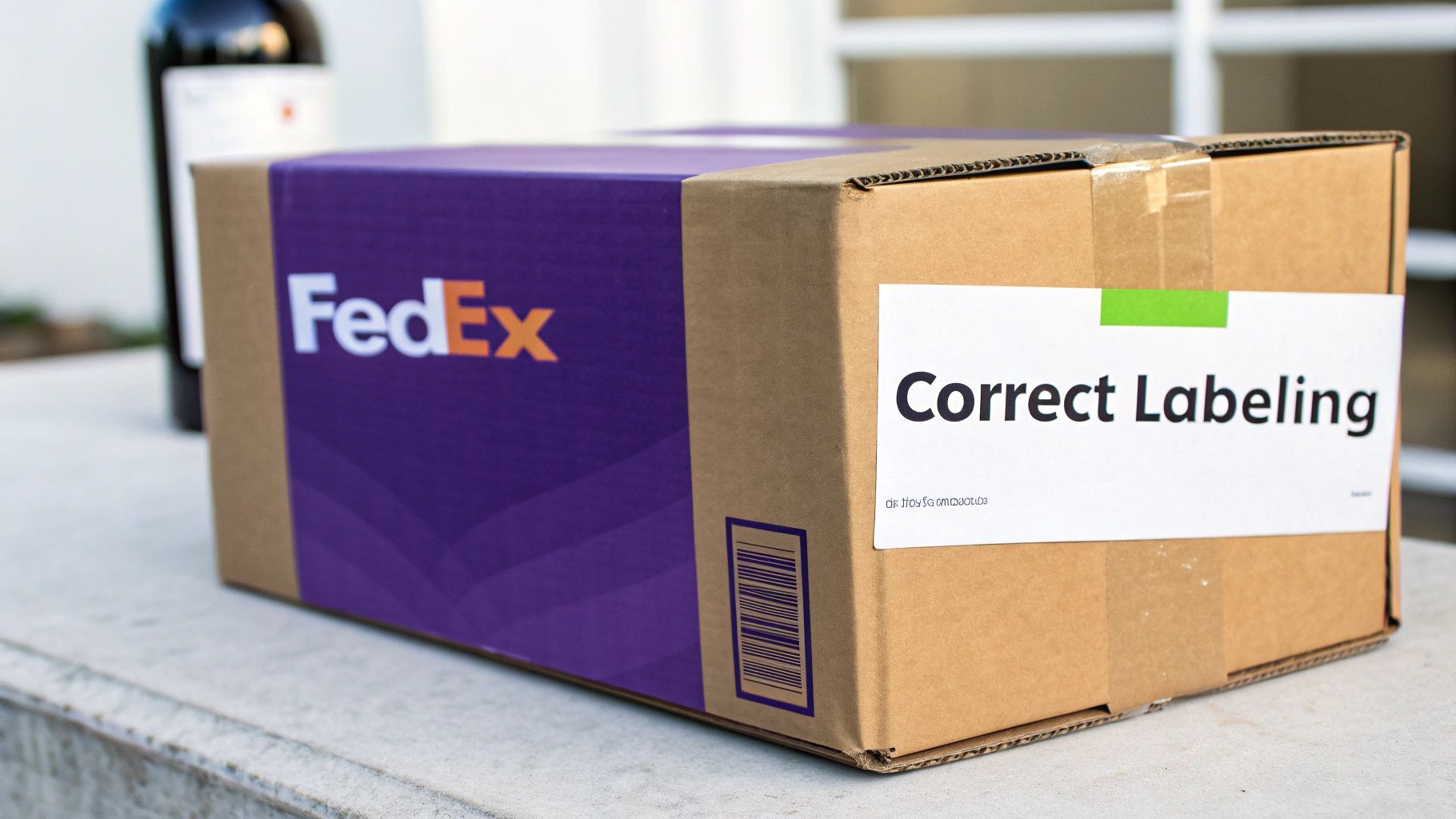
Using FedEx-Approved Packaging
FedEx flat-out requires licensed shippers to use packaging that has been specifically tested and approved for shipping glass bottles. This isn't a friendly suggestion—it's a non-negotiable part of your agreement. The whole idea is to create a rigid, shock-absorbent cocoon for each bottle.
The most common and reliable choices are:
- Molded Pulp Inserts: These are the eco-friendly trays you've probably seen. They do a fantastic job of suspending the bottles in the center of the box, keeping them away from the outer walls.
- Polystyrene Inserts: Often just called Styrofoam, these inserts provide top-notch insulation and impact protection. They're a great pick for more valuable wines or for shipments that will travel through big temperature swings.
These insert systems are designed to fit perfectly inside a tough, corrugated outer box. And whatever you do, never ship wine in its original decorative wooden crate or a flimsy gift box by itself. That beautiful box needs to be placed inside a proper, approved shipper.
Mastering the Labeling Requirements
Getting the labels right is just as critical as the packaging. Your labels are how you communicate vital information to FedEx handlers and ensure you're legally covered when the package arrives. A mistake here can lead to serious delays or send the shipment right back to you.
A package without the correct alcohol and adult signature labels is a massive liability. To the carrier, it signals that the shipper might be cutting corners, putting the shipment at risk of being flagged, pulled aside, and inspected.
Every single wine shipment needs a special label that clearly states it contains alcohol. On top of that, you must apply the FedEx Adult Signature Required sticker.
This is not the same as a generic "Signature Required" sticker. This specific label is mandatory. It tells the driver they have to check a government-issued photo ID to confirm the recipient is 21 or older. There are no exceptions. If an adult isn't home to sign, the package isn't getting left on the doorstep.
Understanding these details is what separates the pros from the amateurs. You can learn more about how different products have unique shipping restrictions that demand similar attention to detail.
Here’s a final pro-tip: use a plain brown box. Avoid any branding on the outside that screams "ALCOHOL INSIDE!" A boring-looking box is far less tempting to thieves. Your goal is a secure, compliant, and discreet package. This one simple move can make a huge difference in reducing theft and loss.
Choosing the Right FedEx Shipping Service
Picking the right FedEx service is more than just a cost comparison—it's one of the most important decisions you'll make to protect the quality of your wine. Think of transit speed as your best defense against the two things that can ruin a perfectly good bottle: extreme temperatures and excessive vibration.
Every extra day a box of wine spends rattling around in a truck or sitting in a warehouse is another day it's exposed to damaging conditions. Your shipping choice needs to match the product.
For instance, a monthly wine club shipment full of sturdy, everyday reds can probably handle the slower, more economical journey of FedEx Ground. The savings really add up when you're sending out hundreds of shipments. But if you're sending a rare, high-value vintage to a serious collector? That calls for a much faster, more protective approach. The extra cost of FedEx 2Day or Priority Overnight isn't just an expense; it's an investment to safeguard a delicate and expensive product.
Domestic Shipping Options Compared
For domestic shipments, licensed wineries and retailers have a few solid choices. Each one strikes a different balance between speed, cost, and risk. When you're making the call, always factor in the time of year and the climate at the destination.
- FedEx Ground: This is the most budget-friendly option, making it the workhorse for high-volume, lower-value shipments. The trade-off is longer transit times, typically 3-7 business days, which means more exposure to the elements. Shipping Ground during a summer heatwave or a winter deep freeze is a gamble.
- FedEx Express Saver: A great middle-of-the-road choice, Express Saver gets your package delivered in 3 business days. It significantly cuts down on transit time compared to Ground, offering a much better balance of speed and cost for many situations.
- FedEx 2Day: This is a popular go-to for more valuable wines. It guarantees delivery within two business days, which dramatically reduces the risk of temperature damage. For many online wine retailers, this is the standard for shipping premium bottles.
- FedEx Standard Overnight: When time is absolutely critical, this is your best bet. It’s the fastest and most expensive service, ensuring next-business-day delivery. This is the white-glove option for irreplaceable vintages or urgent orders where you need to minimize transit time at all costs.
Why International Shipping Is Different
When you start shipping wine by FedEx to another country, the game changes and your options get a lot simpler—for a good reason. The complexities of customs clearance and the sheer distance involved mean that slower services are just too risky. FedEx flat-out prohibits wine on its International Ground service.
For all international wine shipments, you must use an expedited service like FedEx International Priority. This isn't just a recommendation; it's a requirement to ensure the package moves through customs swiftly and spends minimal time in transit.
Using a faster service is the only way to prevent your wine from getting stuck in a customs warehouse for days on end, where temperature control is often a fantasy. The goal is to keep the wine moving, clearing hurdles as quickly as possible to protect its integrity across borders. Picking the right service is the final, crucial step to make sure your carefully crafted and packaged wine arrives exactly as you intended.
Taking Your Wine Business Global
Thinking about taking your wine business beyond domestic borders? It can feel like a huge leap, but with the right logistics partner, it's more achievable than ever. When you start shipping wine internationally with FedEx, you're tapping into a global network designed to connect producers just like you with new, thirsty markets. This isn't just about sending a package; it's about strategically growing your brand on a worldwide stage.
The entire process hinges on two things: meticulous documentation and a solid understanding of the destination country's rules. Every country has its own maze of tariffs, taxes, and import laws. Getting this stuff right from the start is the only way to avoid costly delays, returned shipments, and—worst of all—unhappy customers.
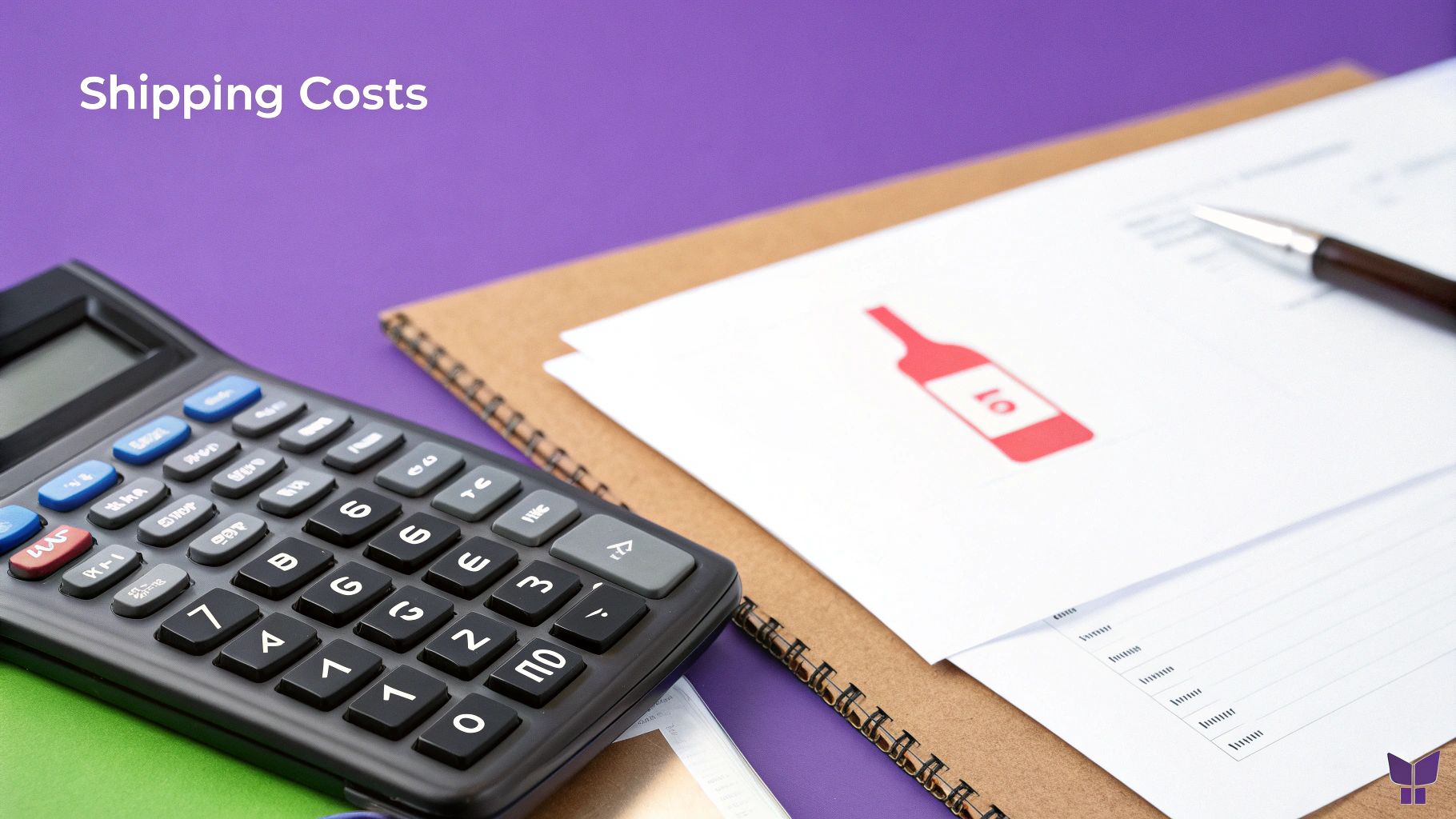
Mastering International Paperwork
Let's get straight to it: the single most important document you'll deal with is the commercial invoice. Don't think of it as just a receipt. It’s a formal declaration for customs officials that details everything about the shipment—the shipper, the recipient, the contents, its value, and where it came from.
Accuracy here is completely non-negotiable. Even a small error, like an incorrect value or a vague description of the wine, can get your package stuck in customs for weeks.
To get it right every time:
- Be Specific: Don't just write "wine." List the exact varietal, vintage, and alcohol percentage.
- Declare Accurate Value: Always use the actual retail value of the wine. Undervaluing shipments to try and save on duties is illegal and can lead to some pretty severe penalties.
- Include All Details: List the number of bottles, volume per bottle (e.g., 750ml), and the total volume of the shipment.
Navigating Customs and Duties
Customs clearance is where many international shipments hit a snag. When your package arrives at the border, officials review your commercial invoice to figure out the duties and taxes owed. These fees, often called tariffs, are almost always the responsibility of the person receiving the wine.
It’s absolutely crucial to let your international customers know about these potential costs upfront. Nobody likes a surprise bill for duties when their wine finally arrives. Being transparent about this process builds trust and manages expectations from the get-go.
"Successfully shipping wine internationally is a game of details. From the commercial invoice to customs declarations, every piece of information must be perfect. FedEx provides the transportation, but the shipper is ultimately responsible for compliance at the border."
This is where FedEx’s massive infrastructure becomes a powerful asset. Their global network and brokerage services can help make the clearance process much smoother, but they rely entirely on the information you provide. A well-prepared shipment sails through, while a poorly documented one creates friction for everyone involved.
A Case Study in Global Expansion
Take a look at the success Australian wineries have had breaking into Asian markets. FedEx has been a key player in this growth, making international direct-to-consumer (DTC) sales a profitable reality.
For example, shipping three bottles of wine from Australia to key markets in Asia via FedEx can cost less than AUD 53—a price point that makes it accessible for a growing middle-class consumer base. Services like automatic tracking and integrated customs clearance help these wineries tap into totally new revenue streams, from tourists who visited their cellar door to members of international wine clubs.
With China once projected to become a top importer of Australian wine, this example shows the massive potential when logistics are handled correctly. You can get more details on how FedEx supports global wine distribution.
Common Questions About Shipping Wine with FedEx
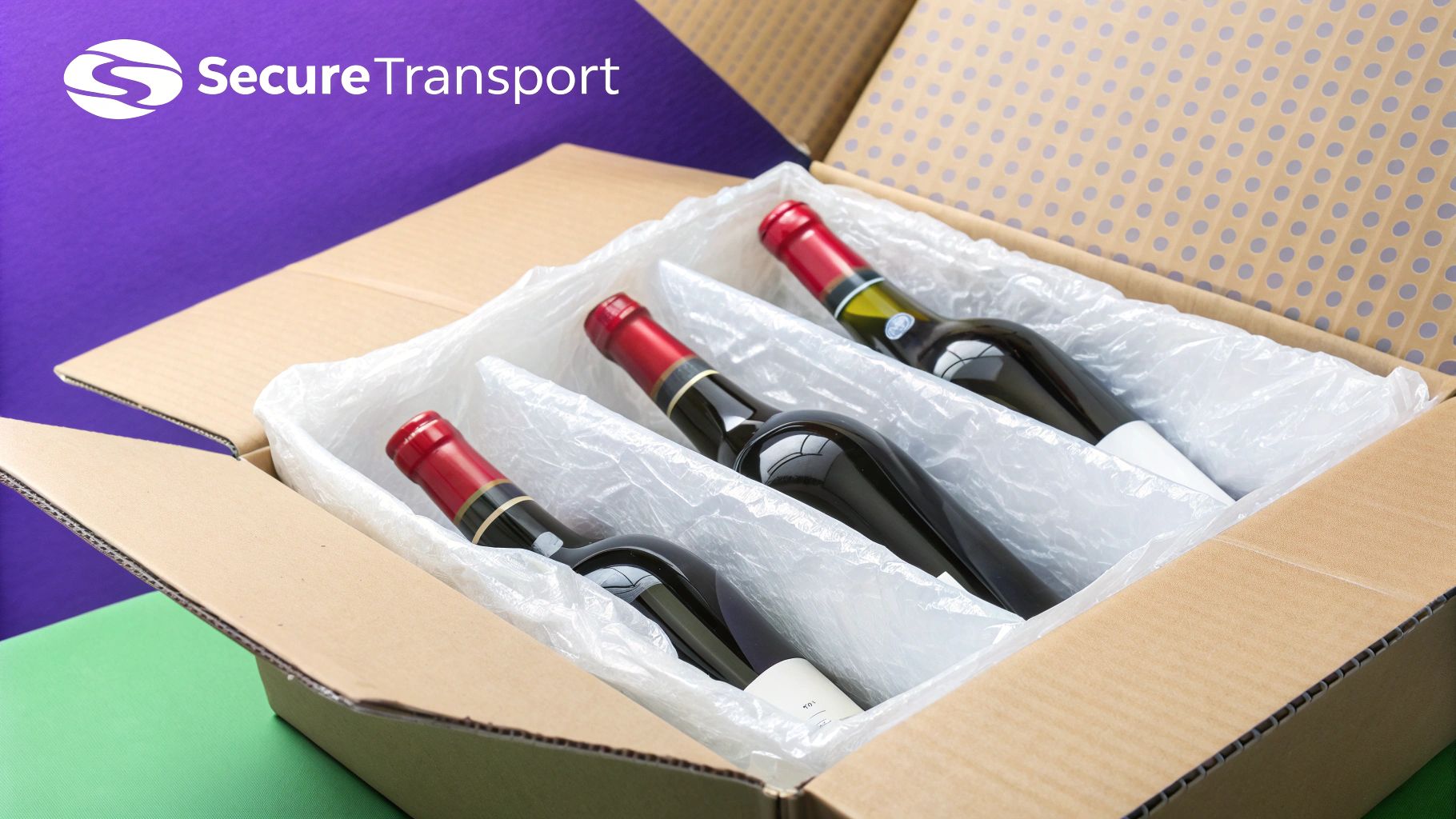
Even with a solid game plan, you're going to have questions pop up once you start shipping wine with FedEx. The rules can get complicated, and let's be honest, unexpected situations are just part of the business. Here are some straightforward answers to the queries we hear most often.
Can I Ship Wine to Any State in the U.S.?
Nope, and this is probably the most critical point to get right. State laws on direct-to-consumer (DTC) wine shipping are all over the map. As the licensed shipper, the legal responsibility falls squarely on your shoulders to verify that the destination state actually allows shipments from your location.
Some states might cap the amount of wine a single person can receive. Others might demand you get a special permit just for their state, and a handful still ban DTC wine shipments entirely. Always, always confirm the laws for both your state and the destination state before you even think about printing a label. It's the only way to avoid costly returns and serious legal headaches.
The most common trap new shippers fall into is thinking that just because FedEx delivers to a state, it's legal for them to ship wine there. Your FedEx agreement gets you access to their network, but state law is what truly dictates where your wine can legally go.
What Is the Most Common Mistake When Shipping Wine?
Hands down, it's improper packaging. If you don't use FedEx-approved materials like molded foam or pulp inserts, you're practically asking for a broken bottle. Worse, FedEx will almost certainly deny your damage claim.
Another frequent misstep is incorrect labeling. Forgetting that mandatory "Adult Signature Required" sticker is a classic rookie error.
A less obvious—but just as important—mistake is using a branded box that screams "WINE INSIDE!" A plain brown box is your best friend; it's far less likely to attract unwanted attention or theft. Sticking to FedEx’s guidelines isn't just a suggestion; it's the surest way to get your wine delivered safely. For more tips on navigating these kinds of rules, our guide on common shipping restrictions for various products is packed with valuable lessons.
Does FedEx Offer Temperature-Controlled Shipping for Wine?
For your typical package shipments, no. FedEx does not offer a standard, built-in temperature-controlled service on its Ground or Express networks. You might find options with FedEx Custom Critical for huge, pallet-sized freight, but that's a completely different service. For the boxes you're sending out every day, protecting your wine from the elements is on you.
This is exactly why insulated packaging is so vital. Most seasoned shippers will hold shipments during extreme summer heatwaves or deep winter freezes. They’ll also frequently upgrade to faster services like FedEx 2Day or Overnight just to slash the time that bottle spends in a potentially hot or cold truck.
How Do I Handle a Damaged or Lost Wine Shipment?
If a package gets lost or shows up looking like it went through a blender, you need to file a claim with FedEx immediately. This is where your prep work pays off. It's crucial to have documented the wine's value and have clear photos of your packaging to prove you followed their strict requirements. The specifics of liability and insurance coverage are all laid out in your FedEx Alcohol Shipping Agreement.
To make the claims process as smooth as possible, have all your documentation ready to go. This means the tracking number, proof of the wine's value, and photos showing both the damaged bottle and the packaging it was in. The more organized you are, the faster it gets resolved.

Cody Yurk
Founder and Lead Developer of ShipRestrict, helping e-commerce businesses navigate complex shipping regulations for regulated products. Ecommerce store owner turned developer.